Art World
‘How This Moment Will Be Misremembered’: An Internet Theorist on What Social-Media Images Hide About the Pandemic
Nathan Jurgenson says our photos of sourdough starters speak to a desire for togetherness and domesticity.
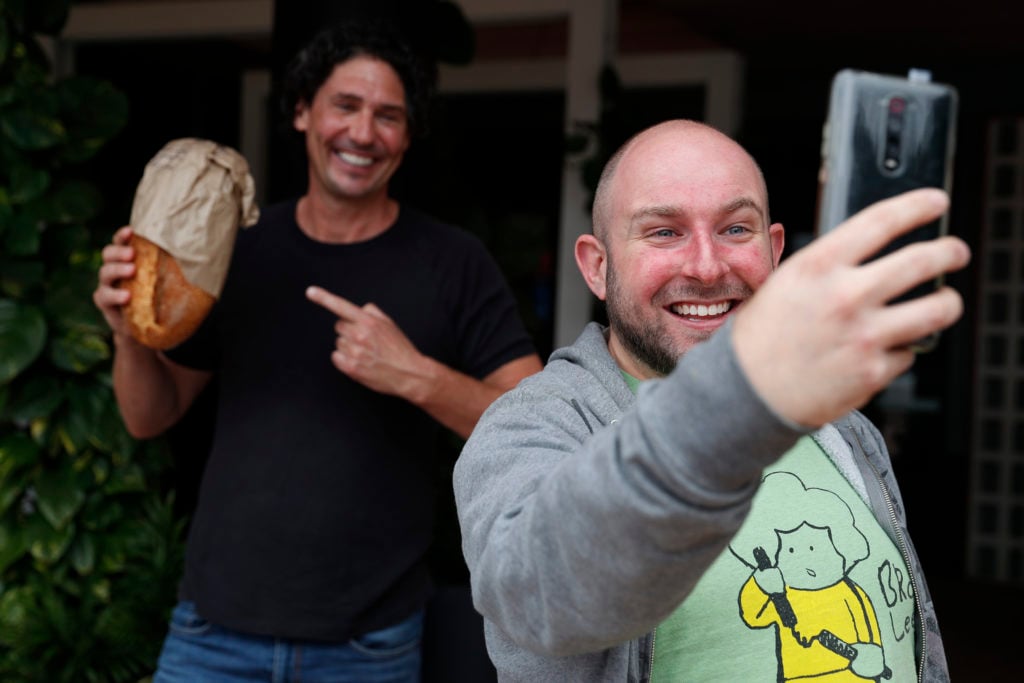
Nathan Jurgenson says our photos of sourdough starters speak to a desire for togetherness and domesticity.

Taylor Dafoe

Empty streets, yawning spring blossoms, sourdough starters: These are the images filling our social-media feeds against the backdrop of an unprecedented pandemic in which hundreds of thousands of people have died. Why the disconnect?
For Nathan Jurgenson, a social media theorist and the founder of Real Life magazine, these images shed light not only on our relationships to the health crisis, but to photography in general. In his book, The Social Photo: On Photography and Social Media, Jurgenson suggests that in today’s ocean of images, the traditional way we have looked at pictures is outdated. He suggests a new way to understand them, one that is “less art historical and more social theoretical.”
We spoke with Jurgenson about his idea of the “social photo,” the usefulness of the term “viral,” and what pandemic image trends tell us about the world today.
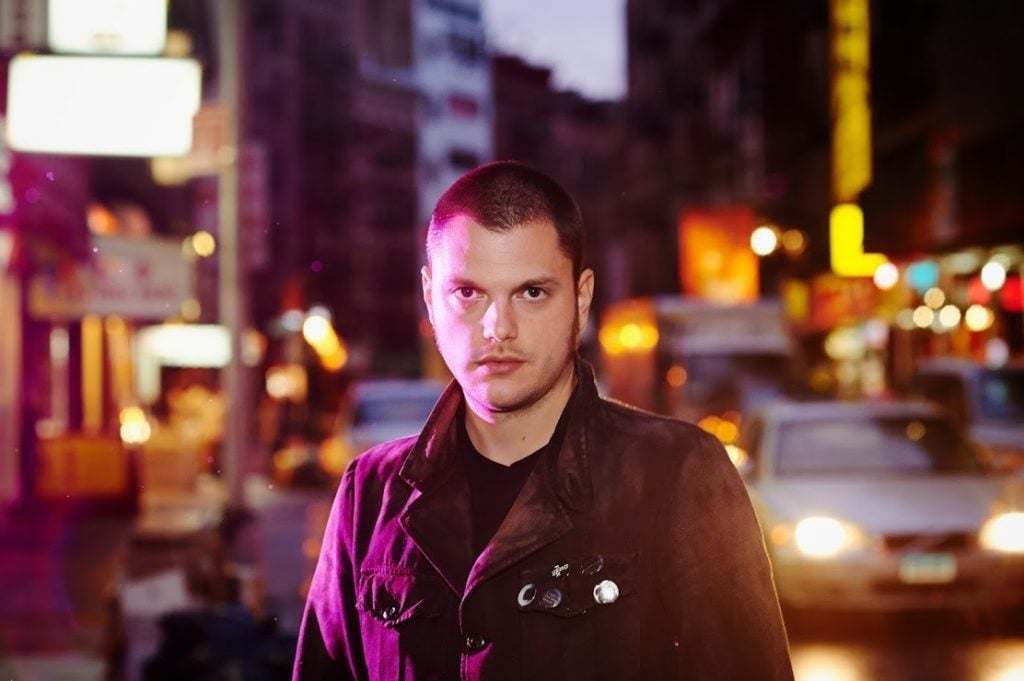
Nathan Jurgenson. Courtesy of the author.
Can you briefly walk us through your notion of the social photo?
The Social Photo is about the vast majority of images taken today, not so much art images or photojournalism, but the everyday practice of taking and sending your snaps, sometimes posting them to many people, more often to one person or a small group. Social photography is more discursive as a practice, less concerned with making art or recording accurate information about a scene. It is more like talking, visually expressing what it is like to be doing what you’re doing and feeling what you’re feeling.
During this pandemic, for people fortunate enough to be safe and able to stay home, the photos being routinely sent back and forth might not be terribly different in content than usual. But I think the bigger point, again for those who are healthy and home, is that our everyday visual communication is probably a lot more mundane than the crisis around us. Our images don’t often depict the pandemic explicitly, say with an ambulance or an unusually empty street, but they likely convey how you are feeling through this. Anxiety, grief, boredom, fear, and exhaustion are often the content of social photos right now, even if they don’t depict something like a face mask. That’s sort of the “social photo” way to read this—that any social photo taken during a pandemic is a pandemic photo. Most photos today deal with our crisis not by what they literally depict, but what they mean, what they are trying to express.
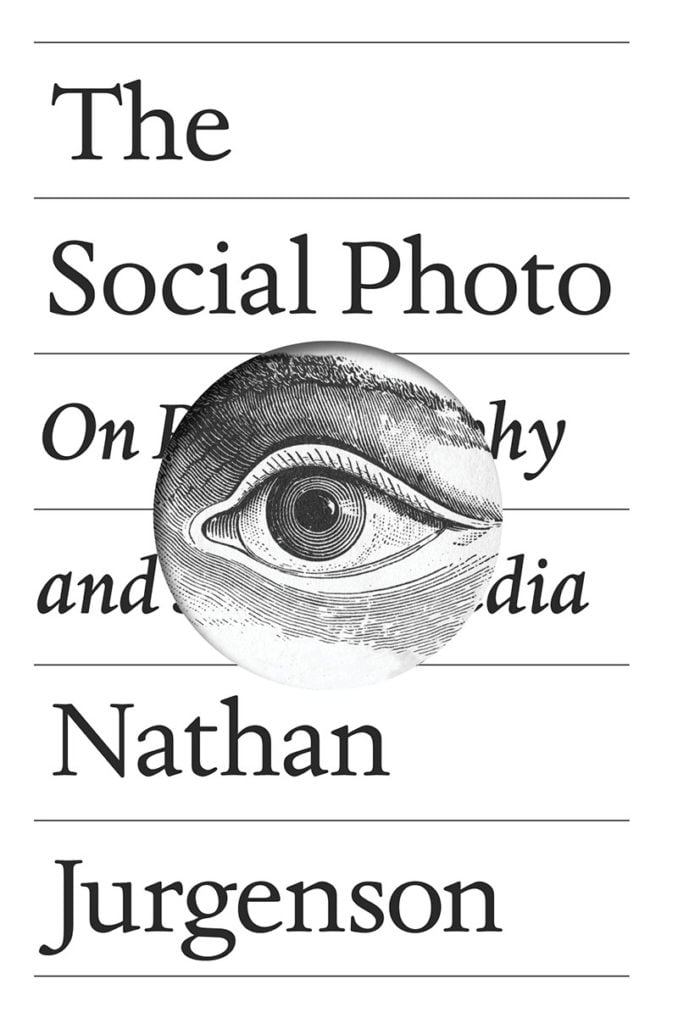
We’ve seen a number of micro-trends in image sharing over the last couple of months: pictures of empty streets, masks, sourdough starters, and so on. Why do you think these are the tropes that have emerged during this time?
There are certainly some new pandemic photo trends. For some reason, I’ve kept a very non-exhaustive list of some of the common image-tropes I see posted right now.
You mentioned sourdough, and that’s certainly been the photo-food of the moment. I think bread photos signify home; or, better, the work of running and maintaining a thriving home. It all contrasts with a pandemic. Usually there are wood tables and cutting boards in the frame. A good knife. Bread creates quite a domestic scene. Sometimes the bread is broken, which conveys eating and health as well as togetherness with others in the home. It’s a scene of living. I’ve seen a lot of images of the starters, or “mothers,” so it makes the nurturing aspect of bread more obvious, as the starter is kind of like a companion, a living thing you take care of as it sustains you. Bread photos also show off the effort and leisure time as well as some special knowledge, supplies, and skill. So the bread photo also conveys cultural capital, an image of how well you are using your time at home.
With mask selfies, like any other selfie, sometimes they are taken, shared, and kept as a reminder of what I look like right now, and future-me might be especially curious about what it was like to be me during this pandemic, to have some evidence that I was here during all of this. It helps remind ourselves that we are in an important moment in time right now, and helps locate ourselves within this moment. I was here, I was doing this.
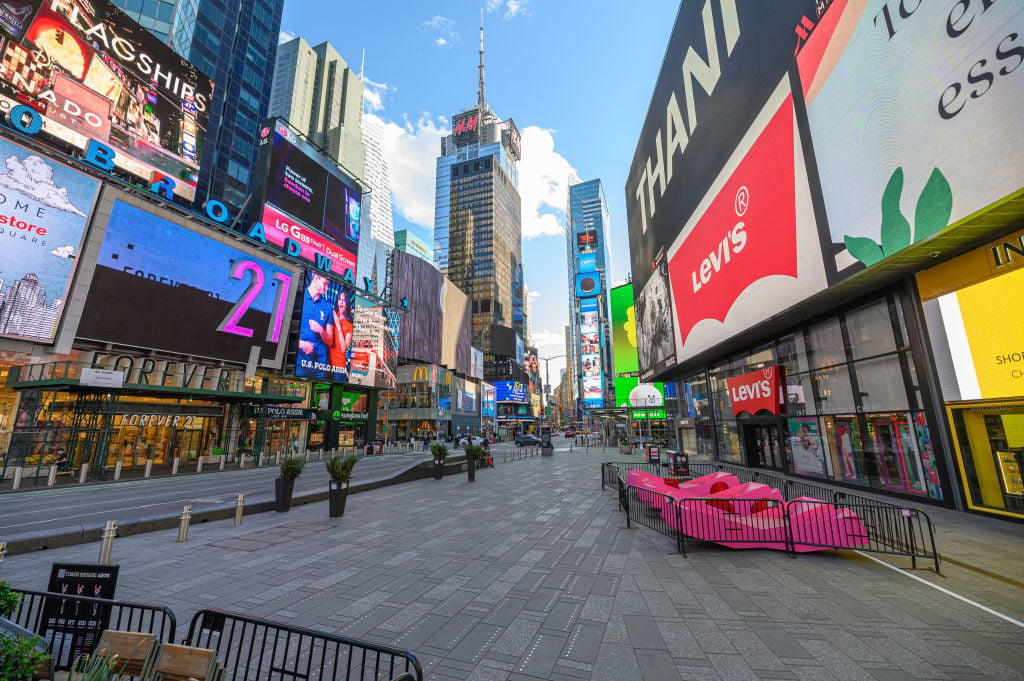
A view of Times Square on May 7, 2020 in New York City. Photo: Noam Galai/Getty Images.
With video-chat backgrounds—video-chat is ostensibly about the foreground, the people talking to each other. But as these video meetings and hangouts are more common right now, people seem more interested in the backgrounds. For friends, coworkers, and public figures, the domestic spaces behind them as they talk have been scrutinized and critiqued in a voyeuristic way. I think a lot of people find having to make part of their private home public to coworkers or even a larger audience is pretty unwelcome. It’s been interesting to see how people deal with that by organizing part of their home to now be “public-ready,” usually some books or something that isn’t too private. I’ve been disappointed by the talk that seeing your coworkers bedrooms makes for more “authentic” conversations or something, because preserving the integrity between private and more public spaces is important.
Many newspapers illustrate their stories about the pandemic with pictures of once-crowded streets that are now empty as people self-isolate. Fortunate enough to be healthy and home, I don’t see much evidence of this world-altering crisis outside my window other than the emptier streets. The inverse is the crowded street, beach, park, or even protest. Every day we are asked to not live our lives as normal, for some at an inconvenience and for others at great sacrifice. Meanwhile, we see images of some people going on as if there wasn’t a pandemic. These folks probably seem greater in number than they are because it’s easier to depict people crowding about than staying in. The photos of empty streets and crowded parks are political images. They are statements of how people in that space are reacting to the virus, most by staying in, and some by going out. A bunch of people all having fun together right now, just doing normal things in abnormal times, appears more shocking to me than an empty Times Square.
— Hugh Jackman (@RealHughJackman) May 4, 2020
How do these images memorialize this moment?
I’ve thought mostly about what is being left out, how this moment will be misremembered. Of all the pandemic photo-trends listed above, I didn’t include photos of the crisis itself. At least here in the United States, there’s so many shots of empty streets and wild animals downtown but very few of the hospitals, the medical workers doing their jobs, the sick, dying, and dead bodies. This exists but is far from ubiquitous, it’s something I have to seek out rather than what I would happen to see. I understand there are various administrative reasons for this, and maybe it says more about being in the US or how poorly I’ve curated my feeds, but I know so many thousands of people are dying all the time and it’s just not depicted as much.
When I look at illustrations and photographs of past plagues and pandemics, I don’t see bread and interiors or calm people in masks, I see bodies in pain, twisted, dead, piled up. But, right now, I have a better visual sense of the small anti-lockdown protests than the much larger lived reality of this medical crisis, which probably serves the ends of those protests.
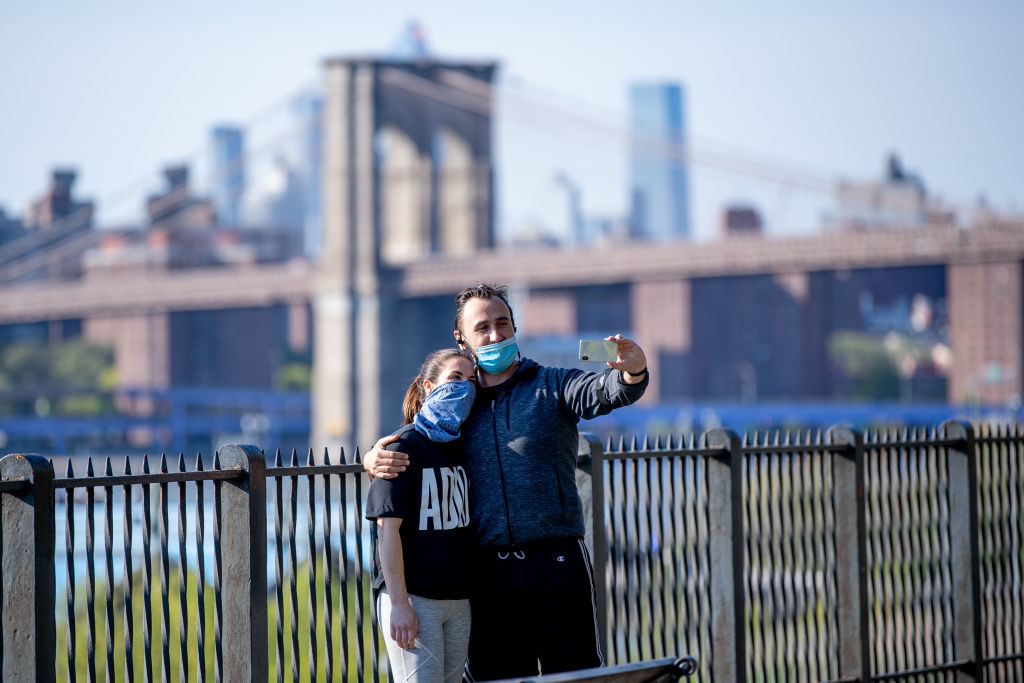
Visitors take a selfie and wear masks at the Brooklyn Heights Promenade with the Brooklyn Bridge in the background on May 10, 2020 in New York City. Photo by Roy Rochlin/Getty Images.
The term “viral” has long been used as a metaphor for the spread of popular images. In the age of the internet, it’s become common parlance. Do you think our relationship to that term will change?
I’ve certainly used that metaphor in the past, that content virality online is like a biological virus. My point is usually that when you design a product or service with viral mechanics in it, those metrics and scores will tend to dominate everything else.
But, right now, I must admit that people doing word play with “viral,” how it conveys both popularity on the internet and the actual pandemic, is a little frustrating. First, it’s too easy. Also, it’s disrespectful to the gravity of our situation. Using the pandemic as a metaphor for talking about how content spreads feels glib against the suffering happening around us.
How are we using the internet or social apps different during this pandemic than before?
A big difference right now is that we are using social, digital tools to replace in-person social interaction rather than to facilitate it. I think a common mistake has always been to assume this was the case, that we are trading in-person contact for the screen. But there is a lot of research that shows quite the opposite, that many use social media to facilitate doing more when away from the screen. What you talk about in a messaging app often has everything to do with what happens when not using a device, and sometimes what you talk about in-person had to do with what you saw on screens. It’s all intermixed.
However, during the pandemic, the internet has been more of a replacement than usual. I’m talking to a lot of people over video and I don’t know when I will see them in-person again. We are doing more of what social media critics have always overstated, using the screen as a replacement. But I’ve been happy that many of those who dismissed screen-based sociality as inherently lacking depth or intimacy seem to better understand its importance and potential right now. Missing friends and family, being able to talk over video is obviously important. It’s obviously real.